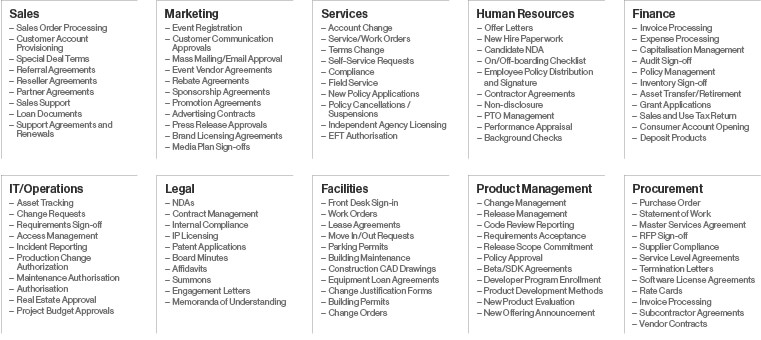
You may be digital, but are your business agreements?

All companies, thriving or otherwise, have one thing in common: they have a System of Agreement. This is the collective set of processes they employ to bring a business interaction to the point of agreement (for example, a contract) and then to manage that agreement from there on.
When a company’s System of Agreement isn’t working well, it hurts its success. There is no doubt that the inability to gain a timely signature on a contract, or to instantly lay your hands on a contract to renegotiate a renewal, negatively impacts a company’s bottom line.
But here’s the thing; even when your System of Agreement is working well, that doesn’t necessarily mean it’s efficient enough to carry you forward into what is fast becoming an entirely digital business environment. A modern System of Agreement, one that automates and connects all of the processes surrounding a business agreement including eSignatures to speed up completion, is a powerful driver of cost savings and efficiency.
The fact is, agreements that are manual, un-trackable and disconnected from your business systems can only scale so far. And, you don’t want to be left holding the pen when the rest of the world has long abandoned paper.
Here are just a few (more than 70!) common agreements used in business, each of which can be made more connected, reliable, compliant and efficient through modernising your System of Agreement.

To help you assess the efficiency of your own System of Agreement, there’s a useful three-minute interactive assessment tool, plus an informative whitepaper available here co-authored by DocuSign, a company at the forefront of digitising agreement processes across industries.
Despite the multiples of agreements across the enterprise, every agreement (or contract, memorandum of understanding, offer of employment, inventory sign-off, and so forth) has four stages:
Preparation
Typically, documents are drawn up from a variety of sources, which range in complexity from a simple Word template to a database-driven electronic form that draws information from CRMs, ERPs, finance software, or public records – as with real estate deals.
Sign
Multiple agreements can go to different parties, including reviewers, approvers, and various signers.
Signers sometimes need validation, and the process – in some cases – needs certification to ensure the legality of the agreement.
Act
Once the signing process is completed, information then flows into back end data systems, like billing systems, CRM records, or HR software.

In many cases, the signing of the agreement triggers processes across different departments or divisions in the business: the creation of a new customer account, to take one example, impacts numerous departments from Customer Services to Finance.
Manage
Retained agreements need to be stored, preferably in a centralised location, for accurate record-keeping, ongoing referral, and also to form the basis of templates for future agreements.
In an ideal world, reports may be produced to analyse and highlight the efficiencies (or otherwise) of the agreement process, and to guide new efficiencies in the future.
DocuSign is the pioneer of eSignature technology, best known for the second stage of the System of Agreement (the ‘Sign’ stage), with 400+ users worldwide successfully leveraging its eSignature platform for remarkable digital transformation. Indeed, as Gartner commented:
“Having reached mainstream adoption, the real-world benefits of eSignature are predictable, broadly acknowledged and have been realised by thousands of organisations across millions of users.” Market Guide for Electronic Signature, January 2017.
Thankfully, electronic signatures are only one part of the golden opportunity available to businesses looking to modernise their System of Agreement. It’s easier than ever to integrate agreement automation using DocuSign’s connectors with popular business systems like CRM, ERP, and HRP. There are powerful APIs which companies can use to build custom integrations. In short, there’s nothing between you and faster, more efficient business processes.
Taking an assessment of your own System of Agreement could prove revealing/enlightening. Consider some of the following:
Time: How long does it take for an agreement to “turn around” in your organisation? Agreements’ processing can be accomplished in minutes, not days or weeks. Are you there?
Cost: By removing or automating agreement steps, labour and revenue costs are hugely reduced. Studies have shown that using DocuSign’s eSignature solution yields a saving of more than US$36 per document.
Loss of customers: Competitors who can deliver a faster, more straightforward process of doing business are taking customers away from those that still have slow, or cumbersome closing processes.
Customer/partner satisfaction: As digital interactions now appear in every facet of all our lives, people are usually unhappy with paper-based forms, signatures and outdated processes in general. Bad reviews spread the fastest.
Compliance: Some companies can’t find all agreements they’ve made in the past. Some hold agreements or contracts in a non-secure manner. And, some even come unstuck when they find themselves referencing an out of date version for business purposes. Are your agreements legally enforceable?
A modern System of Agreement ensures the i’s are dotted and the t’s crossed.
To drive efficiencies in all areas of your organisation where agreements are in place, take this three-minute interactive assessment tool. Alternatively, read more from DocuSign in its handy, downloadable whitepaper, or to kick-start modernising your System of Agreement today, try DocuSign for Free.
READ MORE
- Strategies for Democratizing GenAI
- The criticality of endpoint management in cybersecurity and operations
- Ethical AI: The renewed importance of safeguarding data and customer privacy in Generative AI applications
- How Japan balances AI-driven opportunities with cybersecurity needs
- Deploying SASE: Benchmarking your approach
